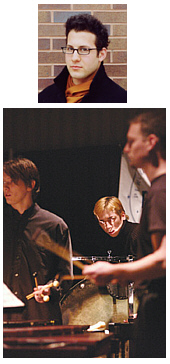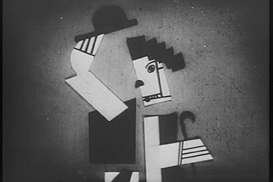




|
|
||||
 |
 |
 |
 |
 |
|
|
||||

Wholly Hopkins Matters of note from around Johns Hopkins
|
|
|
Julian Pellicano, top, conducted a live performance of
"Ballet Mécanique" with, from left, Peabody
percussionists Kevin Dufford on xylophone, Eric Beach on
tam-tam, and Jon Greeney on xylophone. Photo by Bryan Stone |
 Pellicano, a senior majoring in percussion performance at
Peabody and philosophy at Homewood, wanted to give a live
performance of the score synchronized with the film, a feat
no one had ever done before, let alone a student making his
conducting debut.
Pellicano, a senior majoring in percussion performance at
Peabody and philosophy at Homewood, wanted to give a live
performance of the score synchronized with the film, a feat
no one had ever done before, let alone a student making his
conducting debut.
Intrigued by seeing Peabody percussion head Jonathan Haas conduct a 1953 version of the score, and armed with the assurances of Peabody conducting teacher Harlan Parker, Pellicano launched his project with infectious enthusiasm. "He was motivated, resourceful, and positive," Haas recalls. "Not once did I ever hear a single complaint. Not once did I ever hear, 'We can't do this,' or 'Why did we do this.' Because there were many problems." Performing "Ballet Mécanique" was not a simple matter of practice, drive to Ohio, and play. First, Pellicano had to find pianos. The original score was not performed until 1999, partly because no one knew how to synchronize 16 player pianos. The creation of MIDI (musical instrument digital interface), the standard in musical computer languages, and MIDI-compatible player pianos, such as the Yamaha Disklavier, solved this problem. Pellicano got in touch with Michael Bates, academic relations director at Yamaha, who persuaded an Ohio piano dealer to provide 10 Disklaviers. Then, Pellicano had to synchronize his conducting with the film and pianos. Antheil had worked separately from Léger and Man Ray; when the three tried to combine film and score in 1924, the music was nearly twice as long, and the film alone premiered in Vienna. For help with the live performance, Pellicano called Tufts University faculty member Paul D. Lehrman, an Antheil and MIDI expert who had managed the score's 1999 premiere by running the player pianos from his Macintosh computer. Lehrman asked Pellicano to set a tempo. Too slow and the intensity of the music would be compromised; too fast and the musicians would not be able to handle it. Pellicano had ensemble members Jon Greeney and Kevin Dufford play the xylophone parts as fast as they could, and he settled on 110 beats per minute.
|
|
A Cubist Charlie Chaplin in a still from the film
Ballet Mécanique by Fernand Léger and
Man Ray Photo courtesy Anthology Film Archives |
 Working with that tempo, Lehrman made
31 cuts to the score and for rehearsal purposes sent Pellicano a custom-made
CD split into two channels. One channel contained the piano
player parts, as well as digital samples of the siren,
bells, and propellers. The other channel had a "click
track," which would help the conductor keep his place and
stay synched to the film and pianos.
Working with that tempo, Lehrman made
31 cuts to the score and for rehearsal purposes sent Pellicano a custom-made
CD split into two channels. One channel contained the piano
player parts, as well as digital samples of the siren,
bells, and propellers. The other channel had a "click
track," which would help the conductor keep his place and
stay synched to the film and pianos.
Pellicano had picked a doozy for his debut. In its 1,240 measures, "Ballet Mécanique" switches time signatures 600 times. And the time signatures are not straightforward 4/4s or 3/4s, but zany ones like 64/8, 15/16, and 17/32. Lehrman was skeptical. "I wasn't worried about the technical aspect of playing the piece with the film," he says. "It's just that this version had never been conducted by a student." Pellicano says, "I was a little apprehensive because this was my first conducting experience. The difficulty is not getting lost [in the score], but being perfect in the hand." Lehrman flew in from Boston for the performance at PASIC, bringing an Apple iBook that had MIDI tracks for the pianos, samples of the siren, bells, and propellers, and the click track wired to Pellicano's left ear. The 10 Disklaviers were arranged onstage; eight would be controlled by computer (standing in for the 16 called for by the score), the other two played by Peabody pianists Michael Sheppard and Chryssie Nanou. Stage right, beside a battery of bass drums, was the film screen. Lehrman sat offstage with his iBook, hoping it, too, would perform without a hitch. He pressed a button. A tam-tam crashed, leading to brutal, carnally rhythmic chords with lunatic xylophones. The film cut to a woman, swinging and coyly avoiding the camera. Alarming electric bells erupted; on the screen, a roulette wheel spun hypnotically. The siren wailed over rippling player pianos, causing people in the audience near the speakers to plug their ears. The words SOMEBODY STOLE, in French, flashed on the screen. Then, A PEARL NECKLACE. WORTH 5 MILLION. A Cubist Charlie Chaplin twisted in an animated dance; blocks of soldiers marched, ominously. A woman carrying a load on her shoulder walked up steps as she had yesterday, and would tomorrow, and the day after. Soundtrack and film ended together. Pellicano had pulled it off. Afterward, PASIC audience members lauded Pellicano and the musicians for their efforts. Said Lehrman, "It was everything I expected. They did not disappoint." The Peabody Percussion Ensemble plans to give another complete, synchronized performance of "Ballet Mécanique" at Peabody Conservatory on February 17. -- Josephine Yun '02
|
|
|
|
|
Suite 100 | Baltimore, Maryland 21218 | Phone 410.516.7645 | Fax 410.516.5251 |
|